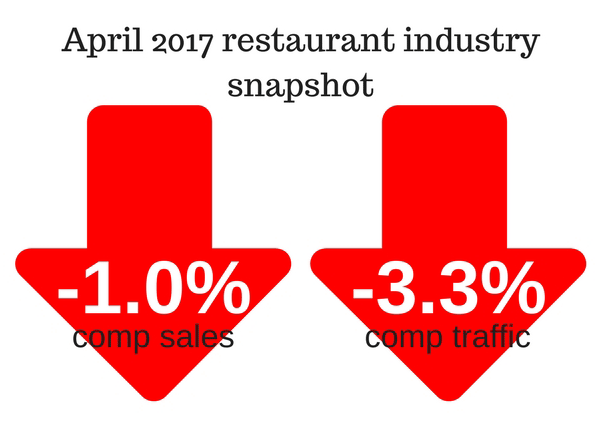Same-store sales declined for the third straight month in April, with results essentially unchanged compared with March.
Sales fell 1 percent for the month, a 0.1-percentage-point improvement from March. This insight comes from data reported by TDn2K through The Restaurant Industry Snapshot, based on weekly sales from over 27,000 restaurant units and more than 155 brands, representing $67 billion dollars in annual revenue.
Traffic fell 3.3 percent in April, representing a modest improvement of 0.1 percentage points over March results.
Annual sales dropped 1.5 percent through April, compared with a 2.3-percent decline in the fourth quarter. If sales remain at April’s levels for the balance of the second quarter, the industry would see its best quarterly performance in over a year.
“There are some reasons to be cautiously optimistic about the second quarter, at least in terms of improvement over what we’ve seen in the recent past,” said Victor Fernandez, executive director of insights and knowledge for TDn2K. “The move of the Easter holiday meant that April’s results were likely softer than they would have been without this shift, meaning spending in restaurants was probably a little stronger than the numbers show. Furthermore, sales started softening considerably starting with June of last year. This translates into easier comparisons when calculating this year’s sales growth rates.”
Other factors are also influencing the industry. Unemployment remains low, but there are some indications of wage growth, according to Fernandez. Consumer confidence is strong, compared with recent years, although it fell in April. Although the economy in general is strong, that hasn’t translated into sustained growth for the restaurant industry, he noted.
The bigger picture
 Mediocre consumer spending caused the economy to grow slowly in the first quarter, according to Joel Naroff, president of Naroff Economic Advisors and TDn2K economist.
Mediocre consumer spending caused the economy to grow slowly in the first quarter, according to Joel Naroff, president of Naroff Economic Advisors and TDn2K economist.
“The key was a cutback in big-ticket purchases after nearly two years of bingeing on things such as vehicles,” Naroff said.
Rising household debt will likely keep consumption, including eating out, suppressed, he noted. But expectations are the real issue. After the presidential election, tax cuts were expected to drive the economy. But these cuts aren’t expected to be passed until the end of the year, and their extent isn’t clear, he said.
“The hope that consumer and business spending will surge is probably just that — hope,” Naroff said. “That said, the economy should rebound this quarter, but it looks like we are in for another year of 2.25-percent growth. While that pace is not likely to make anyone happy, it is enough for the labor market to tighten further and the Fed to continue raising rates, possibly as soon as June.”
Fine dining leads segment performance
The best-performing segments in April, and the only ones with sales increases, were fine dining, upscale casual and family dining.
As has been the case for over a year, upscale casual and fine dining lead in average check amounts and are aligned with a more experience-based dining proposition for a less price-sensitive consumer than mid-scale segments. Sales for all three of these segments appear to have been positively affected by the shift in the Easter holiday.
The weakest segments in April were fast casual and quick service. After years of positive growth as a top-performing industry segment, quick service has experienced a downturn this year. The Black Box Intelligence Market Share Report shows that fast casual is the fastest-growing segment, which indicates possible cannibalization.
Struggles in casual dining continue, although the rate of decline has lessened somewhat. Average traffic growth for 2017 was down 2.9 percent, compared with a 4.1-percent drop in the second half of 2016.
The Restaurant Workforce
Staffing woes persist as hourly employee and restaurant management turnover rates continued to rise, according to the latest data from TDn2K’s People Report. While it may seem impossible for the situation to worsen, restaurant operators continue to predict greater recruiting difficulties in upcoming quarters based on the People Report Workforce Index.
Almost four out of every five restaurant employee terminations in 2016 were workers leaving their jobs voluntarily, and about 40 percent of all hourly employee terminations are within 90 days of hire.
It is particularly challenging to fill back-of-the-house vacancies. Companies responding to a recent People Report survey said they typically receive three times more candidates for front-of-house positions than for the back of the house. Back-of-house positions also take about 40 percent longer to fill. Changes in the immigration landscape will undoubtedly add uncertainty to an already volatile labor market.





